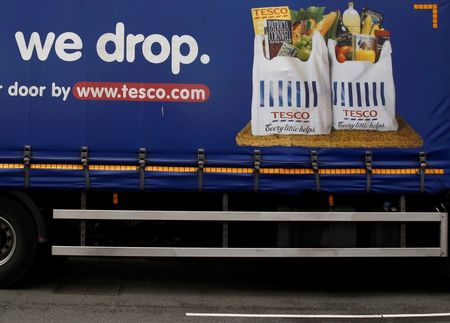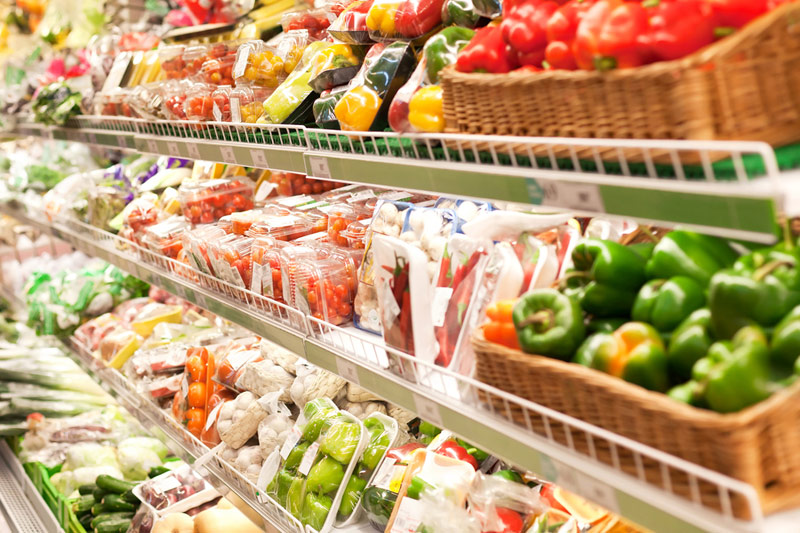By Emma Thomasson
BERLIN (Reuters) - Big retailers are taking a calculated hit to margins to invest in online grocery operations, in the hope they can persuade consumers to add more profitable items like clothes and computers to their orders of fruit and vegetables.
Food has been one of the last things to move online because complex logistics for fresh, chilled and frozen products make it an expensive business. Retailers are also reluctant to lose the potential for the lucrative impulse buys that occur in-store.
However, retailers in Europe and North America are now ramping up their online food offer to compete with Amazon.com, which is expected to expand its sale of fresh produce beyond a few trial areas with the aim of complementing its non-food sales - and eating other retailers' lunch.
"They are trying to hook customers up to brands for their grocery shop and hope they will spend on non-food which is lower headache and higher margin, which will drive profitability," said Sophie Albizua of retail consultancy eNova Partnership.
"It is notoriously difficult to make money selling groceries online. The reason why people do it and need to do it have nothing to do with profit and nothing to do with groceries."
Britain has led the way in selling groceries online, with e-commerce already accounting for some 5 percent of food sales. Other countries like France are now catching up and the Boston Consulting Group (BCG) predicts the global market will grow to $100 billion by 2018 from $36 billion in 2013.
"COMPELLING ECONOMICS"
It has taken Tesco, Europe's second biggest retailer, 17 years to bring its online grocery business close to the industry-leading margins it used to make in its store business.
Tesco made a trading profit of 127 million pounds ($216 million) on online grocery sales of 2.5 billion pounds in 2013, equal to an operating margin of around 5 percent. That beat the 3.7 percent Tesco reported for the group in 2013 - after it was hit by restructuring costs - but came in below group margin at or above 6 percent for the previous three years.
Some analysts suggest that Tesco should focus less on investment in costly e-commerce technology and logistics and more on cutting prices if it wants to stop losing market share in Britain to German discounters Aldi and Lidl.
But Tesco says it is not building its online business for the sake of it: The aim rather is to attract more big-spending food shoppers who also buy general goods, which traditionally sell at much higher margins than groceries.
Tesco customers who buy food online as well as in store spend twice as much as those who only shop in store. Those who also buy general merchandise spend three times as much - although only 4 percent of customers are currently in that last category.
Tesco, which still runs separate operations for online groceries and general merchandise, plans to combine its grocery and general goods deliveries - leveraging the sophisticated logistics network it has built up for food to cut costs for the company, and offer customers a faster service.
The one-hour delivery slots that Tesco offers seven days a week for grocery orders are unmatched by any other general merchandise retailer, including Amazon, points out Tesco multichannel director Robin Terrell.
"As we start to add additional items or additional products to each of those deliveries, the economics become incredibly compelling for us but also a much more compelling offer for customers," Terrell said.
It's a service that would make customers take notice, said Helen Merriot, head of consultancy Accenture's retail practice in Britain.
"If they could combine food and non-food and do that in a really efficient way, using their own supply chain in a joined-up way to get that to the customer when the customer wants it, it would be really powerful," Merriot said.
SLIM MARGINS, SUPERIOR DELIVERY
British retailer Ocado, on track to make its first annual pretax profit this year since it was founded in 2000, set up an online pet store last year from which customers now order goods alongside their food, and plans a kitchen and homeware online store later this year.
Ocado said last week over 30 percent of its orders now contain at least one non-food item as customers benefit from the convenience of the firm's one-hour delivery slots.
Deutsche Bank analysts Niamh McSherry and James Collins predict that general merchandise will grow to 9 percent of Ocado's sales by 2023 from about 3 percent today.
"This is key for the Ocado investment case, namely because it could support the profitability of grocery online retailing and thereby facilitate further penetration of the grocery market," they wrote in a note.
Dutch retailer Ahold, which runs U.S. online grocer Peapod as well as sites for groceries and general goods in the Netherlands and Belgium, is another that plans to keep investing in e-commerce despite the hit to profitability.
In the first quarter, online sales for all Ahold's e-commerce sites grew 20 percent to 362 million euros ($493.79 million), while the group's underlying operating margin slipped to 4 percent from 4.1 percent a year ago. Its online grocery businesses have yet to break even but its Bol.com general merchandise site made an unspecified profit in 2013.
Ahold is using its network of supermarkets as pick-up points for non-food online orders from sister firm Bol.com in the same way that Waitrose in Britain does with partner John Lewis[JLPLC.UL].
Britain's Asda is also investing in collection points, including in car parks of London tube stations, garnering useful information for its owner Wal-Mart, which is testing online grocery in its home market as part of a bigger plan to integrate e-commerce into its sprawling network of stores.
The world's biggest retailer, which made more than $10 billion in e-commerce sales of non-food items last year, warns that investment in online will eat into profits this year.
AMAZON ADVANCES
Most of these traditional players are hoping to have established a bulkhead before Amazon expands its "Fresh" service, which is already combining deliveries of groceries and non-food orders in a few trial U.S. cities like its hometown Seattle.
In areas where AmazonFresh is available, trucks are bundling orders of groceries with a pasta meal or fresh fish from local specialty stores Amazon is partnering with, as well as non-food items like digital cameras and video games.
"Customers who are using our service are not just satisfying one shopping occasion but many shopping occasions," Doug Herrington, Amazon vice president consumables, told the Consumer Goods Forum industry summit in Paris last month.
Bernstein Research predicts that AmazonFresh could generate an operating margin as high as 13 percent in denser urban areas once it overcomes logistical challenges to reach scale.
"A roll out of Fresh could have a material positive impact on order frequency, loyalty, and spend in other non-grocery related categories," Bernstein analysts wrote in a recent report.
Amazon's Herrington expects the pace of delivery will be his future battleground.
"We have yet to find customers who are begging us for slower delivery," he said. "They are going to demand a shorter and shorter window from when you purchase it to when it arrives in your home."

($1 = 0.5877 British Pounds)
($1 = 0.7331 Euros)
(Additional reporting by Martinne Geller and James Davey; Editing by Sophie Walker)
